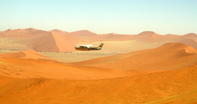
Namibia is vast, even in African terms, and is full of extraordinary landscapes, unique people, big vistas and lots of sunshine. Plus of course a considerable amount of wildlife.
Namibia contains some of the greatest wonders of the natural world, all of which need time to visit, as they are a great distance from each other. For this reason, you should not be in a hurry during a visit to Namibia, as the country is too large and the gravel roads too long for a 'been there, done that' kind of trip.
Although it is far from anywhere, you should not miss the southern Namib Desert, which contains the most astonishing sand dunes in the world. These awesomely enormous Sossusvlei dunes rise to almost 1,000 ft, and change colour with the arc of the sun from vivid orange to brooding purple
Don't resist the urge to sink your bare feet in the warm sands and climb the spine of the dune all the way to the top. Their extreme remoteness only adds to the allure of Sossusvlei, and once there you should stay several nights in one of the nearby lodges to see the desert animals and experience a bedazzling Southern Hemisphere night sky.
If you are ever going to witness a mirage it will be in Etosha National Park in northern Namibia. Its glistening salt pans shimmer and shift to create a hazy horizon, which deceives your eyes. Herds of Oryx, well adjusted to heat and drought, wander across these desolate pans, while other animals survive on the surrounding grass and woodlands, which only come to life after the rains. At this time the hostile saline desert metamorphoses turn into a rich organic lagoon full of Flamingos, Pelicans and a myriad water birds.
Namibia is serviced by a vast network of gravel roads and during an entire day's driving you may only see a couple of other cars. A good reason to seek advice before travelling in Namibia and for choosing fly-in safaris, is because many road fatalities are tourists in hired cars, who are unaccustomed to driving on dirt roads.
Placid nomadic San Bushmen were the original inhabitants of Namibia and have left a legacy of rock art. They became displaced by stronger tribes, some of whom are extremely noticeable today by their distinctive style of dress.
Herero women from the central north are unmistakable in long ankle to neck Victorian dresses - a legacy of missionaries - even though it is 38°C (100°F) in the shade! In total contrast are the beautiful Himba of the north-west, who smear their bodies and entwine their dreadlocks with rich ochre mud.
Like many African countries, Namibia was fought over many times and Germany gained control in 1890. Britain pressured South Africa to invade in 1914 and Namibia came under South African administration until its independence in 1990. These influences explain the mixed traditions and races of this country, but it is for its natural wonders and Etosha's animals that most people pay a visit.

 The people, the rivers, the national parks of Namibia. It's all here in our Namibia Travel Guide. See what goes on in Caprivi, even if it is...
The people, the rivers, the national parks of Namibia. It's all here in our Namibia Travel Guide. See what goes on in Caprivi, even if it is... Everything you need to know about going on safari in Namibia. Read up on Etosha and it's numerous wildlife species as well as lions of the d...
Everything you need to know about going on safari in Namibia. Read up on Etosha and it's numerous wildlife species as well as lions of the d... If you are planning to tour Namibia independently and self-drive, here are some things you need to know about roads and open desert driving....
If you are planning to tour Namibia independently and self-drive, here are some things you need to know about roads and open desert driving.... Find Out about Namibia. Plan your tour and what you want to do. Discover Namibia through the eyes of our various contributing writers......
Find Out about Namibia. Plan your tour and what you want to do. Discover Namibia through the eyes of our various contributing writers......